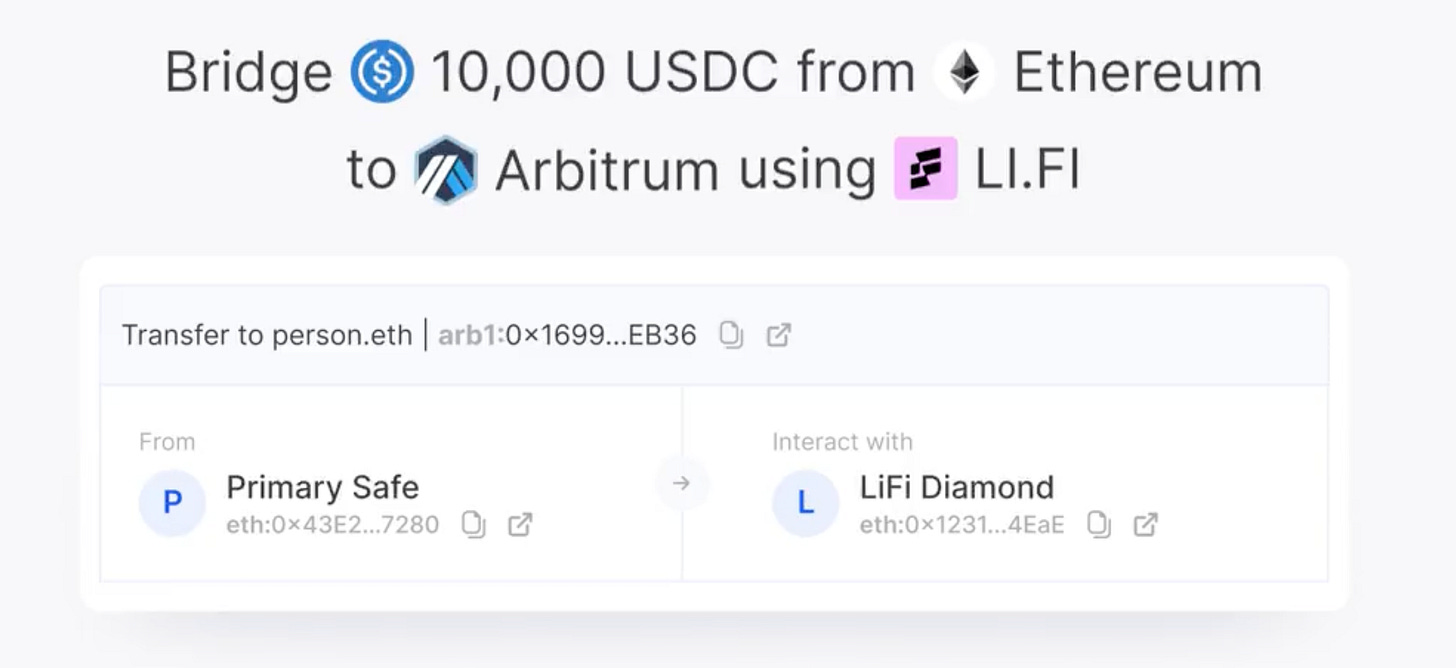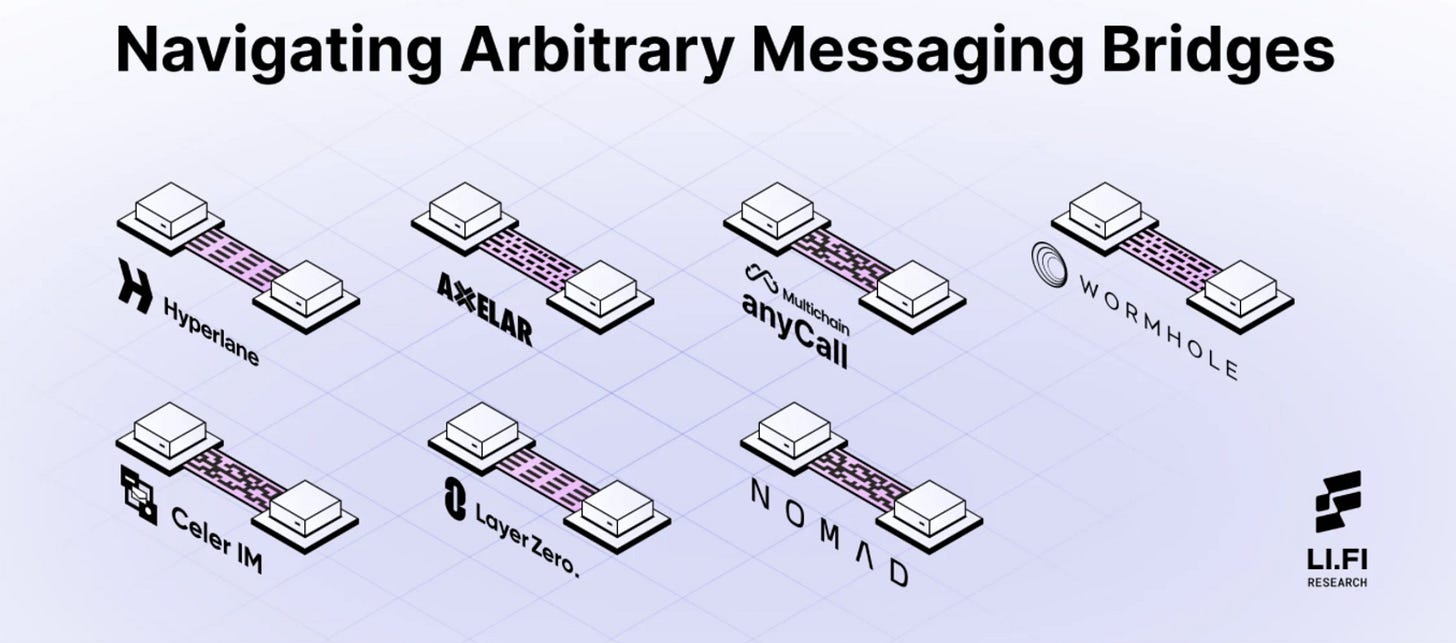Friend.Tech — Hyped or Based? | Multi-Message Aggregation (MMA) & More!
Last Week In The Multi-Chain Ecosystem (14 - 20 Aug '23)
Welcome to LI.FI’s Cross Chain Insider newsletter. If you want to join this community of cross-chain aficionados learning about bridges, interoperability, and the multi-chain ecosystem, subscribe below.
You can also check out LI.FI’s research articles, and follow us on Twitter!
Bridge Updates
1) Connext to Airdrop $NEXT in September 🎉
Connext announced that it will launch its native token NEXT on September 5th. Users can claim their airdrop on four chains: Polygon, Arbitrum, Optimism, and Gnosis Chain. At launch, NEXT will be used to govern the Connext DAO.
2) LI.FI Loyalty Pass on Gateway 💪
LI.FI introduced its Loyalty Pass in collaboration with Gateway Network.
The Loyalty Pass is the first PDA (Private Data Asset), capturing both on-chain and off-chain behaviors. Holders of the Loyalty Pass will enjoy exclusive benefits, including fee reductions, early product access, and special discounts courtesy of our collaborations with partner protocols.
3) Bitcoin on Solana by Threshold Network 👏
Threshold Network announced the launch of Bitcoin on Solana by introducing tBTC, the first tokenized Bitcoin on Solana. This is tBTC’s 1st integration with a non-EVM blockchain, made possible by the Wormhole integration.
4) Moonbeam Routed Liquidity (MRL) by Wormhole 🫡
Wormhole introduced Moonbeam Routed Liquidity (MRL), a one-click feature that can route Wormhole assets anywhere in the Polkadot ecosystem. With the implementation of MRL, every parachain can now access liquidity from Wormhole-connected ecosystems like Ethereum, Solana, among others.
5) DLN integrates Jupiter Exchange 🤝
DLN announced that it has integrated Jupiter Exchange’s API to power native cross-chain trading for any assets on Solana. DLN can now allow users to trade into and out of any asset on Solana.
6) Coinshift Apps: Human-readable dApp interactions from Safe 🔥
Coinshift introduced Coinshift Apps: Human-readable dApp interactions from your Safe, enabling Safe users to create and sign your multi-sig DeFi transactions confidently.
Coinshift Apps loads the dApp inside an iframe, utilizes the Safe Apps SDK, and supports transaction batching, offering human-readable interactions.
Live dApps include:
Aave for lending
CoW Swap and Paraswap for same chain swaps
Paying invoices using Request Finance
You can give it a try by joining the waitlist — http://beta.coinshift.xyz
Multi-Chain Ecosystem Updates
1) Base Activity Soars as Friend Tech Generates >$1M in Fees in 24H 🆙
Friend.tech, a mobile-only social media platform linked to Twitter that tokenizes user accounts, generated over $1 million in fees in 24 hours on Aug 19th, outperforming applications like Uniswap and ecosystems like Bitcoin. Consequently, the number of daily transactions on Base peaked at over 900,000 on August 20.
2) $1.7M Stuck in Shibarium Bridge ⚠️
The Shibarium L2 Mainnet went live on Aug 17 but ran into issues immediately, just a day after its launch, as $1.7M in funds were locked in the network’s bridging from Ethereum. Shibarium developers confirmed that the stuck funds are “safu” and have also insured the entire amount in case of any issue after Shibarium restarts.
3) Immutable zkEVM Testnet is Now Live 👏
Immutable zkEVM, an EVM-compatible zk-rollup L2 dedicated to games, announced its testnet launch.
Sei announced that its Mainnet beta, called Pacific-1, is now live. Users can now bridge and stake $SEI at app.sei.io.
5) Linea ERC20 Token Bridge is Now Live 💪
Linea officially announced the launch of its ERC20 token bridge.
6) CoinEasy to Launch Web3 Social Media Application for Korean Community 🔥
CoinEasy, emerging as South Korea's key portal into the web3 sphere, is set to launch a web3 social media application in collaboration with Orbis.
This venture underscores CoinEasy's commitment to steering the Korean community towards a more decentralized ethos. Join the waiting list: CoinEasy | cryptocurrency
What’s Popping?
Introducing Multi-Message Aggregation (MMA) for Secure Cross-Chain Messaging
In just two years, the focus on bridges within the multi-chain crypto landscape has intensified, and understandably so. As new chains emerge, the critical role of bridges in connecting these chains becomes indisputable. Furthermore, the staggering $2B lost to bridge-related hacks underscores the magnitude of the stakes involved.
At LI.FI, we’ve been analyzing and observing bridges closely, and our learnings can be summarised as follows:
Bridges aren't one-size-fits-all — Each has unique strengths and trade-offs.
No bridge is too big to fail — While Nomad was theoretically perceived as one of the most secure bridges, it still succumbed to a smart contract vulnerability. Similarly, despite Multichain’s dominance in volume and TVL, it went down due to operational security breaches.
The extensibility challenge — A single bridge might not cater to all chains; applications are limited to the bridge’s network of supported chains.
The emergence of new bridges — As the ecosystem matures, new bridges are emerging, boasting enhanced security features. However, many projects already deeply integrated with existing bridges find the transition to new options challenging in terms of resources and implementation.
Reliance on a single bridge — Total dependency on a single bridge can have massive repercussions if things go wrong. The ripple effects of a bridge failure can be catastrophic, impacting all associated partners and magnifying the damage.
It’s evident that there’s a clear gap in the bridging ecosystem, and there’s a need for a solution that addresses some of the challenges mentioned above, especially for use cases of high value, such as cross-chain governance.
In collaboration with the Uniswap Foundation and the dedicated Bridge Committee, LI.FI has crafted the Multi-Message Aggregation (MMA) — an additive security module for cross-chain messaging. This solution is designed to confront and mitigate many issues commonly linked with bridges.
This article delves into why MMA-like solutions are needed and presents LI.FI’s vision for the development and adoption of MMA.
Let’s dive in!
What is MMA?
MMA is a security-first solution to cross-chain messaging, which, instead of relying on a single bridge, creates wrappers or adapters consolidating several verified bridges into a unified cross-chain infrastructure for message relaying.
Developed with an open-source ethos for Uniswap governance and overseen by LI.FI, MMA provides a reliable and secure cross-chain solution for applications by leveraging the security of multiple messaging bridges and keeping each other accountable with a quorum on the destination chain.
The architecture ensures messages sent from a source, like Ethereum, are relayed simultaneously through various bridges. At the destination, if a majority of the bridges relay an identical message, it's deemed valid, and the associated action is triggered.
To understand the nuances of MMA, think of it as a bridge-agnostic cross-chain message aggregation tool. In simpler terms, it allows Uniswap and other dApps to communicate across chains without being tied to a specific bridge. Here’s how the mechanism works:
Source chain: The dApp sends a transaction with payload to the permissionless smart contract through a config contract on chains like Ethereum.
Broadcast Message via Bridges: The payload is sent to destination chains like BNB Chain through multiple messaging bridges trusted and configured by the dApp.
Consolidation of Messages: On the destination chain, the messages are consolidated on the LI.FI Aggregator contract and made sure that each bridge nonce is unique.
Verification of Messages: The message payloads from different bridges are compared with each other to make sure no single bridge is acting maliciously and the payload is approved if there’s consensus among the bridges
Execution of the Payload: As the consensus is reached after the last bridge arrives with the message, the same bridge executes the payload on the dApp contract on the destination chain as we don’t rely on any external relayers.
Key features of MMA include:
Open-Source Public Good: MMA is transparent, community-driven, and available for anyone to inspect, ensuring a higher level of trust and security.
Immutable & Trustless: MMA is designed to be fully immutable and operates on-chain, which means that once an application’s configuration is set, it cannot be altered. This offers unparalleled security and integrity.
ID System for Bridges: Every bridge within MMA gets a unique ID. If there are updates or changes to a bridge, a fresh ID is provided, keeping the original bridge's operations unaffected.
Advantages of leveraging such a system include:
Increased Safety: By using multiple bridges, the system can verify cross-chain messages across different channels, thus enhancing security.
Liveness and Censorship Resistance: Redundancy through multiple bridges ensures the system remains live even if one bridge fails, thus improving censorship resistance.
Flexibility and Extensibility: MMA facilitates the integration of new bridges and allows for the phasing out of outdated ones without causing disruptions. This ensures applications can access the best bridges available and avoid vendor lock-in.
We're currently focused on refining the Uniswap-specific implementation MMA, with a few features left to be added. Soon, we'll expand its testing and submit it for an audit by Trail of Bits. Are you interested in MMA? Check out the Github Repo and consider contributing!
MMA Beyond the Uniswap Specific Implementation
MMA's potential extends well beyond its current relationship with Uniswap. While LI.FI's immediate focus is on catering to Uniswap's requirements, MMA is destined for much broader adoption.
LI.FI envisions MMA as the go-to solution for dApps seeking robust cross-chain governance. We strive to build MMA as a secure, modular, and generalizable tool for unbiased cross-chain messaging.
MMA is beyond the limitations of any single bridge, allowing dApps to enjoy strong security and liveness guarantees with any chain. Imagine MMA as an interface capable of sending messages via any bridge, granting flexibility and customization to access multiple at once.
We’ll add more bridges and chain support for MMA, including non-EVM chains like Cosmos, in the future. More details on the bridges selected for the first iteration of the universal implementation of MMA will be made public shortly.
If these concepts resonate with your project's vision, connect with us and let’s collaborate!
Interesting Reads
1) The Cross-Domain Thesis Part 1: Setting The Stage
2) Beyond Transactions: Implications of intents and projects in the space
3) Ethereum Rollups Demystified: Choosing the Right Rollup for Your Project
4) The Hidden Costs of Modular Systems
Get Started With LI.FI Today
For more information about the LI.FI protocol,
Head to our link portal at link3.to/lifi
Read our SDK’ quick start’ at docs.li.fi
Join the official Discord server
Follow our Telegram Newsletter
Subscribe on our Substack
or try our any-2-any swaps NOW at jumper.exchange








